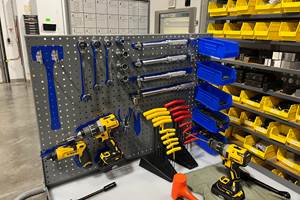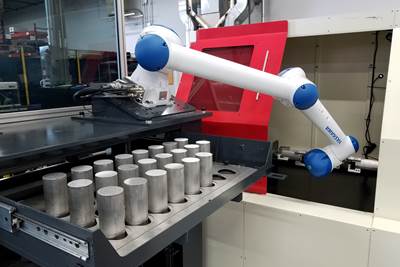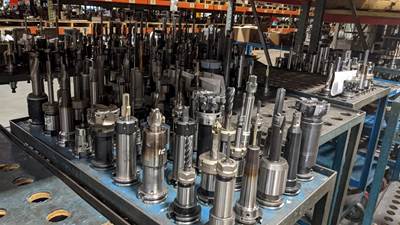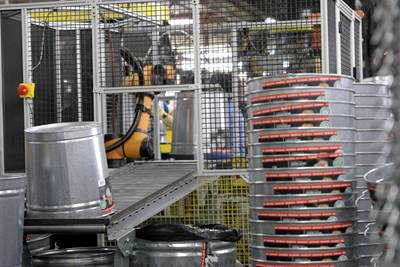Share




Automation is not, strictly speaking, plug-and-play. Even when pairing robots and bar feeders to machines is simple, shops must determine how to reassign their existing staff.
Pro Products Inc. has answered this conundrum by training its employees in value-added activities undertaken in tandem with the robots, an approach that has doubled the shop’s sales since it first began automating in 2014. This balance between robot-driven automation and human-driven secondary operations has also cinched the shop’s position as Modern Machine Shop’s 2023 Shopfloor Practices and Performance Top Shops Honoree.
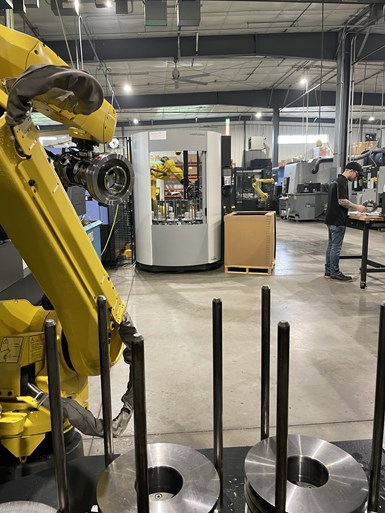
Out of 39 employees at the company, 28 work on the shop floor. After the first shift ends, a skeleton-crew second shift works four days a week to oversee automated production routines and prep for an entirely lights-out third shift during the early morning hours. Images courtesy of Pro Products Inc.
A New Generation of Machining
Steven Hurley, president of Pro Products, is the second-generation president of the company, which was first incorporated in 2000. Hurley and his older brother, Jon, both grew up in the machining industry and witnessed the transition from punched tape NC machines to CNCs. Today, Steven Hurley is leading the charge for Pro Products’ next transition: shopfloor automation.
While the shop has long used bar feeders, gantries and pallet pools, it only acquired its first FANUC robotic arm in 2014. Since then, the shop has continued investing in automation, benefiting from advances in robotics technology. Today, Pro Products deploys nine robots: two M10i robots, four M20i robots and three M70i robots. These robots can work on a wide variety of part sizes and shapes, with weight as the real limiting factor. The M10i robots have a 12-kg limit, the M20i robots a 35-kg limit and the M70i robots a 75-kg limit. The shop combines these robotic arms with twin-turret subspindle CNC machines and other types of machines, aiming to complete machining and secondary operations in a single setup.
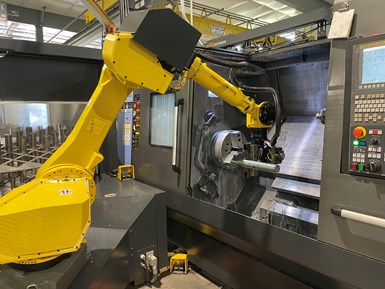
Hurley says the shop’s “secret sauce” for automation implementation is a strong connection between the leadership team and employees. By involving shopfloor employees and discussing automation with them before the first robot arrived, the team built trust in the technology so that operators saw it as a helpful tool rather than an existential threat.
Minimizing Monotony and Mistakes
When Pro Products first began using robots, programming took between three and four hours — comparable to the shop’s CNC programming times. Programming for small orders and shorter cycle times is much more viable now, when programming robots typically takes between 15 and 30 minutes. “It’s become much more practical and profitable to get that robot set up, even for a shorter-run job,” Hurley says, adding that Pro Products puts as much work as possible on its robot-equipped machines. “If it’s one piece, we run it manually. If it’s two pieces, we set up the robot.”
For Hurley, consistency is the greatest benefit that robots offer when it comes to loading and unloading parts. Employees’ productivity naturally varies, whether from being called away to help inspect parts or from tending to other jobs throughout the day. By leveraging robotic automation, Pro Products can maintain a higher level of scheduling predictability, improving quoting accuracy. The consistent strength of the robots also ensures proper loading of unwieldy parts, such as a part that used to require operators to slide a pre-ground bar into the machine chuck while using the chuck as a brace. This would scratch the bar and cause quality issues, whereas the robot can insert the material into machine jaws without touching these jaws.
While often useful, ensuring that this robotic consistency works even when parts themselves vary required some creativity. The shop developed a grid system, with these grids set on turntables or carousels. The robot moves raw material into the machine and returns the finished workpiece to the table, then the carousel turns. Operators can then remove finished goods and place new material on the spaces.
Once the section of the carousel is ready, the operator presses a button, returning it to the robot’s work queue. This system eliminates a lot of repetitive, monotonous work — and with proper planning and scheduling of jobs, enables up to 24 hours of uptime.
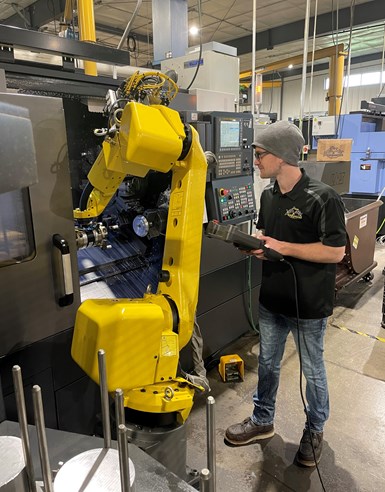
Pro Products’ workholding simplifies consistent part positioning, whether by hand or by robot. Instead, Hurley says, the burden of meeting both the shop’s 0.001-inch standard tolerances and rarer 0.0005-inch tolerances is on its CNC machines.
A High Density of Skill
With robots performing the bulk of loading operations and most of the busywork of machining, what was Pro Products to do with its staff?
Quite simply: Upskill.
With the robots maximizing productivity, Pro Products’ shopfloor staff are not as pressed for time to complete their daily work. The shop has taken advantage of this freed-up time to train its staff, partnering with machine tool distributors and a local technical college to help staff gain experience with more advanced machining procedures. In addition, experienced employees are expected to teach their newer peers, resulting in a workforce with “a high density of skill,” as Hurley puts it.
Pro Products also trains its staff to work in tandem with the robots on inspections, assembly and specialized packaging operations. This has enabled Pro Products to circumvent the need for a dedicated quality department, since most of its shopfloor staff have the skills to perform inspections. The shop does employ two dedicated process specialists, however, to examine current operations, suggest technology or process improvements and increase overall efficiency.
Tandem Benefits
Without automation, Hurley says, the shop would need twice the equipment, between 2.5 and three times the staff and a facility double the size of its current 40,000 square feet in order to match its current level of productivity. The benefits of the robots go beyond just productivity, however.
With robots loading parts in tandem with shopfloor staff performing work that cannot be automated, production labor costs have dropped by as much as 70%. This decrease in cost has allowed the company to increase its machinists’ salary, while also making the company’s quoting more competitive.
Not only has this competitive quoting won Pro Products additional work from its existing local clients, but the decrease in labor costs has enabled it to offset shipping costs and bid successfully for projects from out of state. The shop now only receives 10% of its work from Wisconsin-based clients, insulating Pro Products from local demand fluctuations.
Customers now come from across the US, Canada, Mexico and (in one case) Europe. More importantly, the additional work from these new clients has been steady — Hurley reports over 20% year-over-year sales growth for multiple years running, and sales have doubled since the shop first adopted its robots.
What’s Next for Pro Products?
Currently, full automation only exists within Pro Products’ machining department. The shop is making strides in other departments, such as by purchasing a CNC coordinate measuring machine to speed up inspection, but Hurley and the process improvement engineers are actively searching for technologies that automate more areas of the shop or support existing automation.
This includes attending trade shows, and at IMTS 2022, the team explored the potential of in-machine deburring technologies. Hurley plans to attend IMTS again in 2024, reinvesting his company’s profits to build on the strategies that earned Pro Products its place as this year’s Shopfloor Practices and Performance Top Shops Honoree.
Related Content
Translating a Prototyping Mindset to Production
The experimental mindset that benefited BDE Manufacturing Technologies as a prototype job shop has given it an adaptable edge as a production facility.
Read MoreCutting Part Programming Times Through AI
CAM Assist cuts repetition from part programming — early users say it cuts tribal knowledge and could be a useful tool for training new programmers.
Read MoreIncreasing Productivity with Digitalization and AI
Job shops are implementing automation and digitalization into workflows to eliminate set up time and increase repeatability in production.
Read MoreFour-Axis Horizontal Machining Doubles Shop’s Productivity
Horizontal four-axis machining enabled McKenzie CNC to cut operations and cycle times for its high-mix, high-repeat work — more than doubling its throughput.
Read MoreRead Next
Robots: Doing More With Less Floorspace
Robotic automation continues to grow more accessible to smaller manufacturers, as the floorspace necessary for these robots shrinks and their uses expand.
Read MorePositioned to Prevail: Designing Processes Around People
Stecker Machine Company shows that getting the most value from employees means valuing your employees.
Read MoreKicking RaaS with Robotics as a Service
Robotics as a service (RaaS) enabled Behrens Manufacturing to quickly address a severe worker shortage while maintaining its ability to invest in new metal forming equipment.
Read More
























